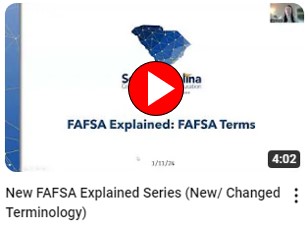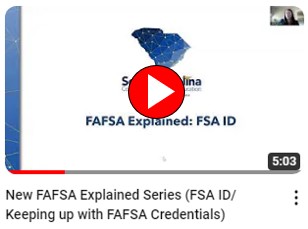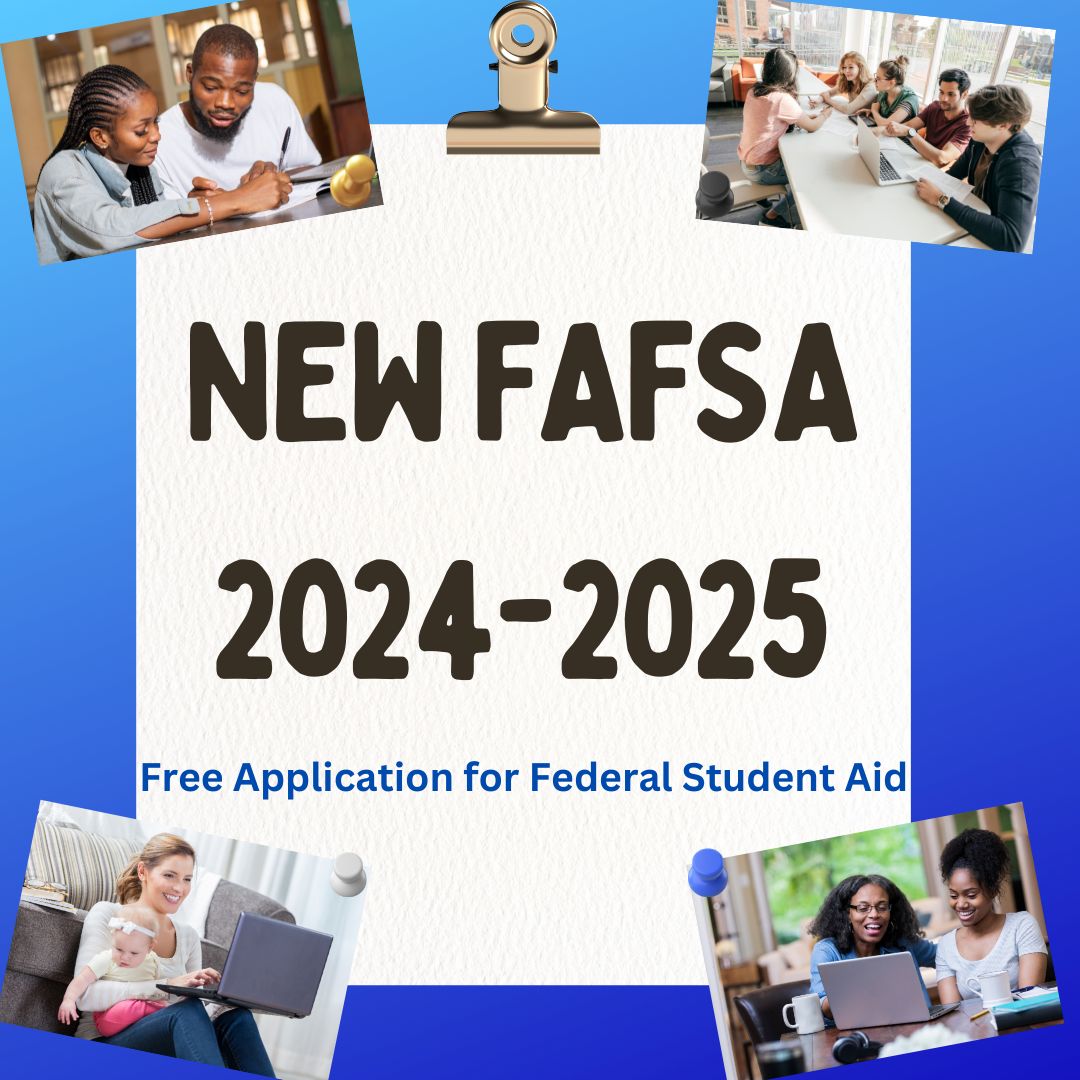The U.S. Department of Education conducted a thorough overhaul of the FAFSA in support of the FAFSA Simplification Act of 2021 - changes went into effect for the 2024-25 school year. In addition to unlocking federal aid, the Free Application for Student Aid (FAFSA) is also used to determine student eligibility for various state-funded financial aid programs at public as well as independent institutions. State financial aid programs include the SC HOPE, LIFE and Palmetto Fellows Scholarships, South Carolina Tuition Grants, South Carolina Need-based Grants (public institutions), South Carolina Lottery Tuition Assistance Grant, and South Carolina Workforce and Industry Needs Scholarships (WINS).
Unfortunately, delays in the rollout of the new FAFSA combined with many changes in the form have led to added stress for students and families, as well as institutions. The CHE has compiled the following Better FAFSA resources to help students and families receive the maximum amount of financial aid they are eligible for in the 2024-25 academic year:
| CHE FAFSA Completion Videos | ||
|---|---|---|
 |  |  |
FAFSA Completion Links and Tools
- CHE FSAID Worksheets:
- FAFSA COMMUNICATION TOOLKIT
- Pro Tips for the 2025-26 FAFSA Form (Federal Student Aid)
- Who Counts as a Parent on the FAFSA Form (Federal Student Aid)
- Guide to Paying for College Class of 2025 Edition (PDF)
- Whose Income Do I Report?
- Playlist: 2025-26 FAFSA how-to videos (uAspire)
- Step-by-Step Instructions for Setting Up an FSA ID (uAspire)
- Student Guide: 6 Steps to Appeal for More Financial Aid (National College Access Network and uAspire)
- FSA ID Handout (Idaho State Board of Education)
- How-to Guide: FSA ID (uAspire)
- How to Get Your FAFSA Submission Summary (uAspire)
- FAFSA Process... Next Steps (EducationQuest Foundation)
- Is My Parent a Contributor When I Fill Out My FAFSA Form? (FSA)
- Federal Financial Aid Estimator Tool (FSA)
- CHE New FAFSA FAQs
Before Completing a FAFSA:
Q: How does a student or parent create a FSA ID?
A: Follow the instructions provided on the worksheets below to complete your FSA ID. Once completed it will take 3-5 days to verify your identity and you will receive an email from Federal Student Aid once your identity has been verified. At that time, you can begin your FAFSA.
Q: What if my parents are undocumented, do they need to create a FSA ID to contribute to my FAFSA?
A: Yes, all contributors will need to complete a FSA ID this year, regardless of their citizenship status. If your parent is undocumented or does not have a social security number, they will answer a set of identity questions from TransUnion when they complete their FSA ID to verify their identity. For mixed status families, please refer to this information and tip sheet for ease in completing the FAFSA.
Completing the FAFSA:
Q: When I search for a college to put on my FAFSA, I can’t find it. How do I add the correct college?
A: Search for the college’s Federal School Code instead of by School Name, this can be done through an internet search.
Q: How do I know which parent I need to invite to contribute to my FAFSA?
A: When you begin your FAFSA, it will ask you a series of questions to help you determine which parent you need to invite to contribute to your FAFSA. You can also use this worksheet to determine which parent will need to contribute to your FAFSA before you begin.
Q: I attend a high school where everyone receives free and reduced priced lunch but I wouldn’t otherwise qualify, should I check the box that I receive it anyways?
A: No – students and parents should only be checking the “free and reduced priced lunch” box if they are financially eligible to receive the benefit, regardless of if they attend a high school where there is universal free lunch.
Q: My family size is different than what is reflected on my FAFSA, what should I do?
A: Students and parents should answer “Yes” to the opportunity to “Review Family Size” and update family size when it’s possible to make corrections to their FAFSA.
After Completing the FAFSA
Q: I need to make a correction on my FAFSA but when I login to correct it, I’m not allowed to correct anything, how come?
A: The FAFSA is not currently available to make corrections. Any student or parent that needs to make a correction to their FAFSA will need to wait until their FAFSA has been processed by Federal Student Aid. This will likely be in mid-March but could be delayed further. Students will receive email notifications when their FAFSA has been processed, which is the indicator that they are able to go in and make corrections.
Q: What if I signed and submitted my FAFSA but my signature gets removed?
A: Re-sign your FAFSA, even if you’re not making any changes to the form.
Q: What if my signature disappears after I sign and submit my FAFSA?
A: Share your diagnostics with Federal Student Aid directly or with your school counselor – take a screenshot, provide what browser you used, time and date, and application ID. Provide these details in an email to Federal Student Aid’s Help Center or email your school counselor with this information so they can report it to the CHE.
Q: What happens after I submit my FAFSA?
A: The student will receive a FAFSA Submission Summary (FSS) once their FAFSA has been processed. This will be emailed to them directly from Federal Student Aid. Currently, FAFSAs are scheduled to be processed in the first half of March, students should expect to see an email containing the FSS by March 15th pending further date changes from Federal Student Aid.
These FAQs address the most common questions and issues we have noticed, however, more questions develop each day. If you couldn't find the answer to your question, you can refer to Federal Student Aid’s 2024-25 FAFSA Issue Alerts webpage where common scenarios and workarounds to these scenarios are provided. You can also report any issues you run into while completing the FAFSA directly to Federal Student Aid by emailing their Help Center.
You may also report any issues or challenges you are experiencing with the FAFSA to Kathy Rollins, CHE college access consultant. Please be specific about the challenge you are experiencing, what you have already done in attempts to resolve the challenge, and any screenshots or data you can provide to support your work in overcoming the challenge.
- What you need to complete a FAFSA
Required information: Where to find it: Student and parent 2024 Federal Income Tax forms and all schedules Personal records or visit irs.gov/transcript Student and parent FSA ID usernames and passwords Create student and parent FSA IDs at studentaid.gov—allow five days for the Social Security Administration to verify the FSA ID Student and parent email addresses Personal records Student and parent Social Security numbers Personal records or call the Social Security Administration at 800.772.1213 Student and parent dates of birth Personal records Student and parent savings/checking account balances Personal banking records Student and parent investments (i.e. stocks, bonds, mutual funds, 529 plans, rental properties) excluding home and retirement Personal financial records Current net worth of all businesses
Current net worth of all farms (if applicable)
Personal financial records Child support received from the LAST complete calendar year (if applicable) Personal banking records or Contact Child Support Services Center at 1.800.768.5858 Student Alien Registration Number/USCIS Number for eligible non-citizens (if applicable) Contact U.S. Citizenship and Immigration Services at uscis.gov - New FAFSA Benefits and Features
 The simplified, redesigned, and streamlined 2024–25 FAFSA form is estimated to provide Pell Grants to more than 610,000 students from low-income backgrounds. Additionally, Pell recipients will receive more aid with nearly 1.5 million more students receiving the maximum Pell Grant. The new FAFSA is the most significant overhaul of the FAFSA form since its inception, almost four decades ago.
The simplified, redesigned, and streamlined 2024–25 FAFSA form is estimated to provide Pell Grants to more than 610,000 students from low-income backgrounds. Additionally, Pell recipients will receive more aid with nearly 1.5 million more students receiving the maximum Pell Grant. The new FAFSA is the most significant overhaul of the FAFSA form since its inception, almost four decades ago.The new FAFSA will also include many changes to make it easier to complete, according to information from the State Higher Education Executive Officers Association (SHEEO):
- It will import more elements from IRS tax return data, resulting in fewer overall questions for students and families, and fewer verifications.
- It is predicted to average larger Pell Grant awards, and an increased number of students eligible for Pell.
- It establishes a minimum Pell Grant award based on Adjusted Gross Income, automatically qualifying some students for Pell.
- Changes the Expected Family Contribution to the Student Aid Index. The SAI can be as low as negative $1,500. It has fewer factors in the formula and more elements imported from IRS tax return data, requiring fewer FAFSA questions.
- Students are no longer required to enroll in Selective Service to file the FAFSA.
- Eliminates the prohibitions on eligibility for incarcerated students and students with drug-related offenses.
- The new FAFSA will use tax forms to determine family size.
- Eliminates the provision that divides the expected contribution by the number of family members enrolled in college.
- Requires small businesses/family farms to report as assets (previously businesses/family farms with less than 100 employees were excluded).
